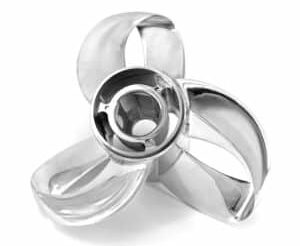Loop Propellers – Prop Innovation From Sharrow Marine – BDOutdoors | Bloodydecks

Will these new loop propellers make your old bladed prop obsolete?
As if it wasn’t already hard enough to choose the best propeller for your fishing boat, a company called Sharrow Marine has developed a completely different kind of prop. Basic propeller design hasn’t changed in close to a century—until now—with what might best be called a “loop” propeller. Essentially, rather than having blades that grip the water to provide thrust, it has metal loops on its hub.
Yes, this is more than just a little bit odd. What’s going on here is an attempt to eliminate the cavitation and vortices created by “normal” propellers at the blade tips. Do so, and you should see speed and efficiency boosts plus a drop in vibration. So, how do you get rid of cavitation and vortices? How about simply getting rid of the blade tips, in the first place? By creating a propeller with the blades replaced by loops, there are essentially no tips whatsoever.
Sharrow didn’t just dream this up—poof!—and start making props. A seven-year designing and testing phase included some rather advanced methodology, including CAD modeling, dynamometer testing with scale models, and dye-injection flow testing at the University of Michigan’s Hydrodynamics Laboratory. Sharrow didn’t introduce their props until this year, at the 2020 Miami International Boat Show. And the entire process has generated 46 US and international patents.
The bottom-line advantage? Third-party testing has shown an overall nine- to 15-percent efficiency advantage, higher top-end speeds reduced vibration levels, reduced sound levels, and enhanced handling.
Another advantage of this design relates to blade area. While each blade on a regular propeller provides one surface area, each loop actually provides two. The more blades a propeller has, generally speaking, the better balanced it is and the less vibration it creates. Since a three-loop Sharrow really has six blade surface areas, vibrations are notably muted in comparison to those created by a regular three-blade propeller. The additional blade area also means the prop can do better at getting a heavy load onto a plane (Sharrow points out that boats equipped with one of their props can get onto a plane at significantly lower rpm) and has more bite on the water when operating in reverse.
So: if the Sharrow design is so clearly superior to regular old-school props, are we going to see everyone rush out and buy one? Not today. As usual, there’s a fly in the ointment. Also, as usual, it’s cost. Unlike the massive casting operations run by most modern propeller manufacturers, up to now Sharrow has been custom-producing their initial offering, the MX-1, one at a time. Each propeller has been cut out of billet aluminum with a five-axis router, which results in a rather expensive $4,500 starting point for a single three-loop aluminum propeller. Stainless-steel CNC-machined models start at $9,000 each. Ouch.

The good news? Sharrow had their first cast-made prop in-hand, at the Miami show—where they were awarded an NMMA Innovation Award for the propeller.
“Winning the Innovation Award at the Miami International Boat Show this year was an incredible moment for us at Sharrow Marine,” says company president Greg Sharrow. “We have been working with many prominent boat builders and engine manufacturers who want the Sharrow Propeller MX-1 to be the new gold standard for their line of vessels and motors. By attending MIBS and winning the Innovation Award, Sharrow Marine was brought us to the attention of a whole new group of boatbuilders and household name engine manufacturers who are now engaged in custom designs and sea trials. Boatbuilders, in particular, recognize the significant performance and fuel efficiency gains the Sharrow Propeller is bringing to the industry. There hasn’t been this level of propulsion innovation literally in their lifetimes, so they are very excited.”
As of this writing, the new cast props weren’t yet being mass-produced and the company hadn’t yet announced pricing. But Sharrow says they will be “only slightly more expensive and competitive with” old-school props, and they expect to have the casting operation running full-tilt in short order. When that happens, many of us may soon be trading in our obsolete blades, to get ahold of those loops.
